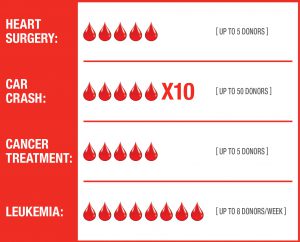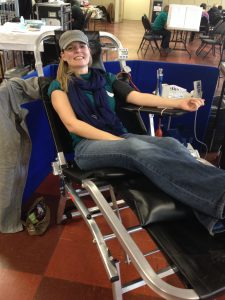 Winter is one of the hardest times of the year to collect enough blood products to meet patient needs – bad weather can make it hard for people to get to blood drive locations, and seasonal illnesses can make some donors unable to donate (although only temporarily). January is National Blood Donor Month, where people who can donate blood are encouraged to consider doing so, either for the month or throughout the year ahead.
Winter is one of the hardest times of the year to collect enough blood products to meet patient needs – bad weather can make it hard for people to get to blood drive locations, and seasonal illnesses can make some donors unable to donate (although only temporarily). January is National Blood Donor Month, where people who can donate blood are encouraged to consider doing so, either for the month or throughout the year ahead.
We’ve all heard the ads on the radio or the TV when there’s a need for blood donations, but it’s not often we get specific information about the process or what’s involved when deciding to donate blood, plasma, or platelets.
To help you understand the donation process, we’ve put together some key information so you can make an informed decision about whether you would like to become a donor.
Who Is Eligible to Donate?
- You must be over 17
- You must weigh at least 110lbs and be in generally good health
- If you are a regular donor:
- Blood can be safely donated every 56 days
- Platelets can be given every seven days (up to 24 times per year)
- Plasma can be donated every 28 days (up to 13 times per year)
Who Does a Blood Donation Help?
 Knowing exactly how your blood donation helps someone is key! When you donate blood or blood products (like plasma or platelets), you have a chance to help everyday medical care, including surgeries, managing diseases, and procedures.
Knowing exactly how your blood donation helps someone is key! When you donate blood or blood products (like plasma or platelets), you have a chance to help everyday medical care, including surgeries, managing diseases, and procedures.
Specifically, plasma supports the immune system and helps control excessive bleeding. These donations are important to help treat bleeding disorders, liver diseases, and cancer patients.
Platelets help with clotting, so if you cut yourself, platelets are released and blood begins to clot. Platelet donations can help patients who have long-term bleeding due to diseases like cancer.
Image credit: Canadian Blood Services
Why Should I Donate Plasma or Platelets?
It takes multiple donations of whole blood (typically 4-6) to provide enough plasma or platelets to support one patient due to the small amount recovered. With this, focusing your donation type can be helpful if you want to support a particular need.
Plasma and platelet donations have a similar process to whole blood donations, but the blood passes through a centrifuge to return the rest of the blood to your body.
Tips for Successful Blood Donation
 As much as possible, you should plan your donation ahead of time to enhance your comfort. Some tips to consider:
As much as possible, you should plan your donation ahead of time to enhance your comfort. Some tips to consider:
- Drink plenty of water on the day of your donation
- Wear comfortable clothes and make sure you can roll your sleeves above the elbow
- Always include iron-rich food, like spinach, red meat and strawberries, in your diet, especially in the weeks leading up to your donation
- If you are on any medications, make sure you bring a list of their names so that you can share that information at check in
- Make sure you have government issued ID with you or, if you’re a regular, your donor card
- Relax and be sure to hydrate once you’ve made your donation
For more information on how you can donate blood in your area, visit either American Red Cross or Canadian Blood Services.
We’d love to hear about your donation stories and the inspiration for why you do it, so be sure to connect with us on Facebook and Twitter.

